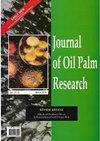SELECTIVE CYTOTOXICITY EFFECTS OF R-GLYCIDOL AND S-GLYCIDOL ON VERO AND HCT 116 CELLS IN EVALUATING THE INCIDENCE OF GLYCIDYL ESTERS IN EDIBLE OILS AND FATS
IF 1.3
4区 农林科学
Q2 Agricultural and Biological Sciences
引用次数: 0
Abstract
Despite their feasibility as food flavouring, glycidol is classified as a probable carcinogen under group 2A by WHO. The cytotoxicity effects of isomers of R-and S-glycidol on African green monkey kidney normal cell lines (Vero) and human colon cancer cell line (HCT 116) remain unclear. Cell viability of the treated Vero and HCT 116 cells was determined using the AlamarBlue ® assay. Dichlorodihydrofluorescein diacetate (DCFDA) was used to evaluate reactive oxygen species (ROS) activity. Protein expressions of ERK ½, p-ERK, Bcl-2 and caspase-3 were investigated using western blotting technique. The findings indicated that R-and S-glycidol (1.16 µg/mL) exposure dramatically reduced the cell viability of the treated HCT 116 cells but was slightly cytotoxic to Vero cells, hence triggering ROS activity. R-and S-glycidol cause down-regulation of ERK ½, p-ERK, and BCL-2 protein expression at 48 h of treatment. Furthermore, both R-and S-glycidol possess close interaction in proximity to 3D-structure of human ERK and p-ERK protein receptors. In conclusion, R - and S -glycidol potentially triggered oxidative stress and affected ERK protein phosphorylation, leading to caspase-3 independent cell death of the treated HCT 166 cells, suggesting that lower doses (<1.16 µg/mL) of R - and S -glycidol are safe for human consumption在评估食用油和脂肪中缩水甘油酯的发生率时,r -甘油酯和s -甘油酯对vero和HCT 116细胞的选择性细胞毒性作用
本文章由计算机程序翻译,如有差异,请以英文原文为准。
求助全文
约1分钟内获得全文
求助全文
来源期刊

Journal of Oil Palm Research
农林科学-食品科技
CiteScore
2.60
自引率
30.80%
发文量
69
审稿时长
>12 weeks
期刊介绍:
JOURNAL OF OIL PALM RESEARCH, an international refereed journal, carries full-length original research papers and scientific review papers on various aspects of oil palm and palm oil and other palms. It also publishes short communications, letters to editor and reviews of relevant books. JOURNAL OF OIL PALM RESEARCH is published four times per year, i.e. March, June, September and December.
 求助内容:
求助内容: 应助结果提醒方式:
应助结果提醒方式:


